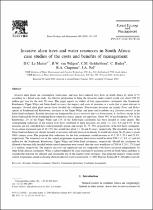 ResearchSpace
ResearchSpace
Invasive alien trees and water resources in South Africa: case studies of the costs and benefits of management
JavaScript is disabled for your browser. Some features of this site may not work without it.
- ResearchSpace
- →
- Research Publications/Outputs
- →
- Journal Articles
- →
- View Item
| dc.contributor.author |
Le Maitre, David C

|
en_US |
| dc.contributor.author |
Van Wilgen, BW

|
en_US |
| dc.contributor.author |
Gelderblom, CM

|
en_US |
| dc.contributor.author |
Bailey, C

|
en_US |
| dc.contributor.author |
Chapman, RA

|
en_US |
| dc.contributor.author |
Nel, JA

|
en_US |
| dc.date.accessioned | 2007-02-08T07:02:36Z | en_US |
| dc.date.accessioned | 2007-06-07T10:02:24Z | |
| dc.date.available | 2007-02-08T07:02:36Z | en_US |
| dc.date.available | 2007-06-07T10:02:24Z | |
| dc.date.issued | 2002-05-01 | en_US |
| dc.identifier.citation | Le Maitre, DC, et al. 2002. Invasive alien trees and water resources in South Africa: case studies of the costs and benefits of management. Forest Ecology and Management, vol 160, 03 January, pp 143-159 | en_US |
| dc.identifier.issn | 0378-1127 | en_US |
| dc.identifier.uri | http://hdl.handle.net/10204/1630 | en_US |
| dc.identifier.uri | http://hdl.handle.net/10204/1630 | |
| dc.description.abstract | Invasive alien plants are consumptive water-users, and may have reduced river flows in South Africa by about 6.7% according to a broad-scale study. An effective programme to bring the invasions under control would cost about US$ 92 million per year for the next 20 years. This paper reports on studies of four representative catchments (The Sonderend, Keurbooms, Upper-Wilge and Sabie-Sand) to assess the impacts and costs of invasions at a scale that is more relevant to managers. Several alien plant species have invaded the catchments. Non-riverine invasions are mainly Pinus and Hakea species in Sonderend and Keurbooms, eucalypts in the Upper Wilge, and pines and scramblers (e.g. Lantana camara) in the Sabie-Sand catchment. Riverine invasions are dominated by Acacia mearnsii and, to a lesser extent, A. dealbata, except in the Sabie-Sand and the lower Sonderend River where Eucalyptus species are important. The impacts and costs are significant and are comparable with those calculated independently for other South African catchments. Water is acknowledged to be a key constraint to economic growth in South Africa and there is considerable pressure for efficient and sustainable use of the limited water resources. The projected impacts would justify control programmes aimed at clearing alien invader, for water conservation. | en_US |
| dc.format.extent | 251606 bytes | en_US |
| dc.format.mimetype | application/pdf | en_US |
| dc.language.iso | en | en_US |
| dc.publisher | Elsevier Science BV. | en_US |
| dc.rights | Copyright: 2002 Elsevier Science B.V. | en_US |
| dc.subject | Plant invasions | en_US |
| dc.subject | Resource economics | en_US |
| dc.subject | Forestry | en_US |
| dc.subject | Commercial plantations | en_US |
| dc.subject | Catchment management | en_US |
| dc.title | Invasive alien trees and water resources in South Africa: case studies of the costs and benefits of management | en_US |
| dc.type | Article | en_US |
| dc.identifier.apacitation | Le Maitre, D. C., Van Wilgen, B., Gelderblom, C., Bailey, C., Chapman, R., & Nel, J. (2002). Invasive alien trees and water resources in South Africa: case studies of the costs and benefits of management. http://hdl.handle.net/10204/1630 | en_ZA |
| dc.identifier.chicagocitation | Le Maitre, David C, BW Van Wilgen, CM Gelderblom, C Bailey, RA Chapman, and JA Nel "Invasive alien trees and water resources in South Africa: case studies of the costs and benefits of management." (2002) http://hdl.handle.net/10204/1630 | en_ZA |
| dc.identifier.vancouvercitation | Le Maitre DC, Van Wilgen B, Gelderblom C, Bailey C, Chapman R, Nel J. Invasive alien trees and water resources in South Africa: case studies of the costs and benefits of management. 2002; http://hdl.handle.net/10204/1630. | en_ZA |
| dc.identifier.ris | TY - Article AU - Le Maitre, David C AU - Van Wilgen, BW AU - Gelderblom, CM AU - Bailey, C AU - Chapman, RA AU - Nel, JA AB - Invasive alien plants are consumptive water-users, and may have reduced river flows in South Africa by about 6.7% according to a broad-scale study. An effective programme to bring the invasions under control would cost about US$ 92 million per year for the next 20 years. This paper reports on studies of four representative catchments (The Sonderend, Keurbooms, Upper-Wilge and Sabie-Sand) to assess the impacts and costs of invasions at a scale that is more relevant to managers. Several alien plant species have invaded the catchments. Non-riverine invasions are mainly Pinus and Hakea species in Sonderend and Keurbooms, eucalypts in the Upper Wilge, and pines and scramblers (e.g. Lantana camara) in the Sabie-Sand catchment. Riverine invasions are dominated by Acacia mearnsii and, to a lesser extent, A. dealbata, except in the Sabie-Sand and the lower Sonderend River where Eucalyptus species are important. The impacts and costs are significant and are comparable with those calculated independently for other South African catchments. Water is acknowledged to be a key constraint to economic growth in South Africa and there is considerable pressure for efficient and sustainable use of the limited water resources. The projected impacts would justify control programmes aimed at clearing alien invader, for water conservation. DA - 2002-05-01 DB - ResearchSpace DP - CSIR KW - Plant invasions KW - Resource economics KW - Forestry KW - Commercial plantations KW - Catchment management LK - https://researchspace.csir.co.za PY - 2002 SM - 0378-1127 T1 - Invasive alien trees and water resources in South Africa: case studies of the costs and benefits of management TI - Invasive alien trees and water resources in South Africa: case studies of the costs and benefits of management UR - http://hdl.handle.net/10204/1630 ER - | en_ZA |





